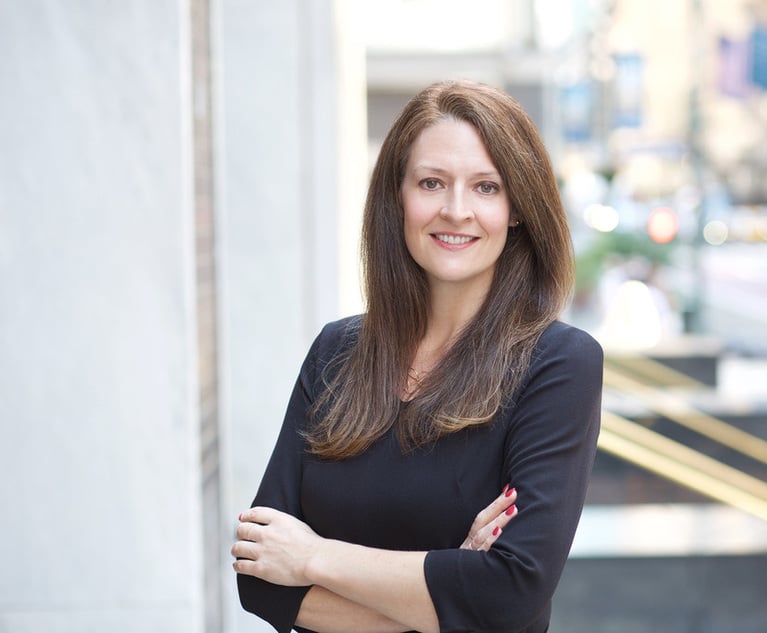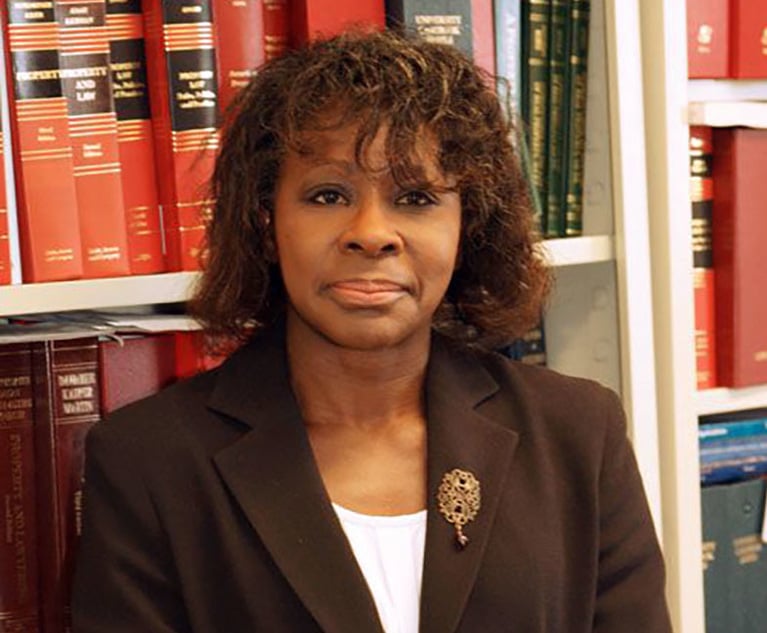The Right To Vote Is Central to Full Participation in Our Society
Alan Scheinkman, Presiding Justice of the Appellate Division, Second Department, writes about the successes of women in law and the judiciary, and the barriers that still exist to true gender equality.
April 30, 2020 at 02:04 PM
6 minute read
 Justice Alan Scheinkman
Justice Alan Scheinkman
In commemorating the centennial of the ratification of the 19th Amendment to the United States Constitution, we pay homage to the constitutional enshrinement of female suffrage as the most prominent milestone in the ongoing struggle for the equality of women in this country. While attainment of the most basic right to participate in the democratic process of selecting our national, state, and local leaders was both overdue and historic, it is waypoint—a significant one—on our continuous and yet incomplete journey to complete gender equality. At this vantage point, 100 years removed from the event, we regard it as inconceivable that more than one-half of our adult population should ever have been denied the right to vote.
The female suffrage movement is widely regarded as having originated at a convention held in Seneca Falls, N.Y. in the summer of 1848. Despite strong leadership and a compelling message, the women's rights movement would wait another 72 years before securing the right of women to vote in our nation's elections. Along the way, women began to break down the barriers that had been erected against them. In 1885, Kate Stoneman became the first woman to pass the New York Bar Examination but was initially denied admission because of her gender. However, the Legislature passed, and Gov. David B. Hill signed, a law allowing women to practice law, and Ms. Stoneman was admitted. At the turn of the century, Helen Z.M. Rodgers of Buffalo became the first woman to argue a case before our Court of Appeals. She participated in many appeals and served as the Chair of the Committee on Suffrage and Qualifications for Office of the 1938 New York Constitutional Convention.
Those who advocated for women's suffrage were confronted with widespread and deeply entrenched beliefs underlying the proposition that women were unsuited for involvement in political matters. Having become more involved in the economy because of joining the workforce in larger numbers during World War I, women were at last able to overcome these pervasive beliefs and achieve the required majorities in Congress and the state legislatures for a constitutional amendment. We can only imagine the sense of accomplishment that Kate Stoneman had when she served as a poll watcher in the Albany city elections in 1918 and saw women voting.
The adoption of the 19th Amendment established the status of women as participants in our country's democratic processes. Now that women were permitted to be involved in choosing their leaders, women began to assert their right to be leaders. No doubt because women had the right to vote, elected officials began to appoint women to important positions and political leaders began to nominate women for elective office. In 1935, Justine W. Polier became the first female judge on the Domestic Relations Court, the precursor to today's Family Court. In 1939, Judge Polier was joined on the Domestic Relations Court bench by Jane Matilda Bolin, who was the first black woman to graduate from Yale Law School, the first to join the Association of the Bar of the City of New York, the first to join the New York City Law Department, and the first to serve as a judge in the United States. In 1959, Birdie Amsterdam became the first woman to be elected to the New York State Supreme Court.
Standing on the shoulders of these pioneers have been dynamic leaders of the courts in our own time. New York's judiciary has benefitted greatly from the wise direction of our first female Chief Judge, Judith Kaye, and that of our current Chief Judge, Janet DiFiore, who is skillfully leading our courts through an unprecedented public health crisis and who has been a fierce advocate for judicial excellence. Similarly engaged in judicial leadership are the Chief Judges of both the Southern and Eastern Districts of New York, Colleen McMahon and Roslynn Mauskopf.
The first woman to serve on my own court was Geraldine Eiber, appointed in 1984. Justice Eiber was joined shortly thereafter by Sondra Miller, who was one of the first women to graduate from Harvard Law School and who has played such a vital role in the development of New York's family law. Our court was privileged to have as our Presiding Justice the amazing A. Gail Prudenti, who later became Chief Administrative Judge and Dean of Hofstra Law School. Our court presently has a near majority of women—10 of 21 Justices are women—and it is not unusual for a panel to have a female majority and, at times, even to be exclusively female. We are incredibly fortunate to have both Ruth Balkin and Cheryl Chambers as members of our constitutional court, with Justice Chambers being the first female of color to have attained that position. They, together with Justice Sheri Roman, regularly participate as justices presiding over our court sessions.
While progress has made, there is much more to do. While women now represent approximately 50% of the student body in our nation's law schools, the National Association of Women Judges and the National Women's Law Center have reported that, at both the state and federal levels, less than 35% of American judges are women. In the private sector, the landscape for women's equality remains particularly challenging. Glass ceilings remain in place, and equal pay for equal work—a proposition that seems beyond any possible question—remains surprisingly elusive.
The reasons for the slow and unsteady progress toward the goal of equality over the past 172 years are complex, but it appears that certain persisting attitudes about gender roles are a contributing factor. The expectation that women will assume most or all of the responsibility for raising children and performing household chores has not entirely disappeared. Although the opportunities for women to pursue careers in law and other professions have increased, women, more so than men, may be required to make choices between advancing their careers and devoting their attention to their home and family. In this sense, inequality persists.
The 19th Amendment gave women the right to vote, which was critical in the advancement of women's rights, but did not, by itself, bring about complete gender equality. Civil rights legislation on the federal, state and local levels has created enforceable rights and has led to recompense for discriminatory acts that have occurred; regular, consistent judicial enforcement of those rights has undoubtedly served to deter at least some from perpetuating such acts. The adoption of remedial legislation, as well as the appointment and election of women to public office, simply would not have happened without the door to participation in our democracy having been opened to women. For that, we have the 19th Amendment to thank.
NOT FOR REPRINT
© 2025 ALM Global, LLC, All Rights Reserved. Request academic re-use from www.copyright.com. All other uses, submit a request to [email protected]. For more information visit Asset & Logo Licensing.
You Might Like
View All


Trending Stories
- 1African Law Firm Investigated Over ‘AI-Generated’ Case References
- 2Gen AI and Associate Legal Writing: Davis Wright Tremaine's New Training Model
- 3Departing Attorneys Sue Their Former Law Firm
- 4Pa. High Court: Concrete Proof Not Needed to Weigh Grounds for Preliminary Injunction Order
- 5'Something Else Is Coming': DOGE Established, but With Limited Scope
Who Got The Work
J. Brugh Lower of Gibbons has entered an appearance for industrial equipment supplier Devco Corporation in a pending trademark infringement lawsuit. The suit, accusing the defendant of selling knock-off Graco products, was filed Dec. 18 in New Jersey District Court by Rivkin Radler on behalf of Graco Inc. and Graco Minnesota. The case, assigned to U.S. District Judge Zahid N. Quraishi, is 3:24-cv-11294, Graco Inc. et al v. Devco Corporation.
Who Got The Work
Rebecca Maller-Stein and Kent A. Yalowitz of Arnold & Porter Kaye Scholer have entered their appearances for Hanaco Venture Capital and its executives, Lior Prosor and David Frankel, in a pending securities lawsuit. The action, filed on Dec. 24 in New York Southern District Court by Zell, Aron & Co. on behalf of Goldeneye Advisors, accuses the defendants of negligently and fraudulently managing the plaintiff's $1 million investment. The case, assigned to U.S. District Judge Vernon S. Broderick, is 1:24-cv-09918, Goldeneye Advisors, LLC v. Hanaco Venture Capital, Ltd. et al.
Who Got The Work
Attorneys from A&O Shearman has stepped in as defense counsel for Toronto-Dominion Bank and other defendants in a pending securities class action. The suit, filed Dec. 11 in New York Southern District Court by Bleichmar Fonti & Auld, accuses the defendants of concealing the bank's 'pervasive' deficiencies in regards to its compliance with the Bank Secrecy Act and the quality of its anti-money laundering controls. The case, assigned to U.S. District Judge Arun Subramanian, is 1:24-cv-09445, Gonzalez v. The Toronto-Dominion Bank et al.
Who Got The Work
Crown Castle International, a Pennsylvania company providing shared communications infrastructure, has turned to Luke D. Wolf of Gordon Rees Scully Mansukhani to fend off a pending breach-of-contract lawsuit. The court action, filed Nov. 25 in Michigan Eastern District Court by Hooper Hathaway PC on behalf of The Town Residences LLC, accuses Crown Castle of failing to transfer approximately $30,000 in utility payments from T-Mobile in breach of a roof-top lease and assignment agreement. The case, assigned to U.S. District Judge Susan K. Declercq, is 2:24-cv-13131, The Town Residences LLC v. T-Mobile US, Inc. et al.
Who Got The Work
Wilfred P. Coronato and Daniel M. Schwartz of McCarter & English have stepped in as defense counsel to Electrolux Home Products Inc. in a pending product liability lawsuit. The court action, filed Nov. 26 in New York Eastern District Court by Poulos Lopiccolo PC and Nagel Rice LLP on behalf of David Stern, alleges that the defendant's refrigerators’ drawers and shelving repeatedly break and fall apart within months after purchase. The case, assigned to U.S. District Judge Joan M. Azrack, is 2:24-cv-08204, Stern v. Electrolux Home Products, Inc.
Featured Firms
Law Offices of Gary Martin Hays & Associates, P.C.
(470) 294-1674
Law Offices of Mark E. Salomone
(857) 444-6468
Smith & Hassler
(713) 739-1250







